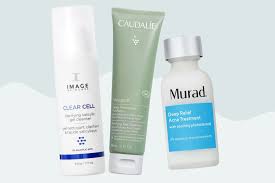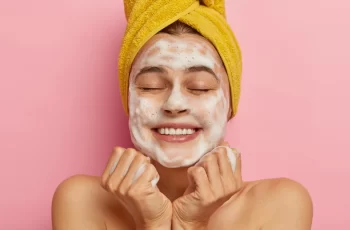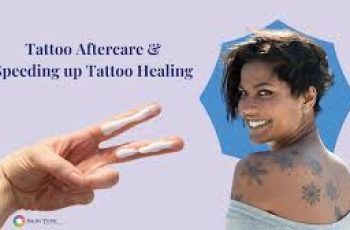Can You Use Salicylic Acid Over Primer?
It’s well known that having a well-established skincare routine can affect the look of your makeup. We have received a few questions recently about using skincare ingredients and makeup products. For some it may come as a surprise to hear that your skincare can alter the way your makeup products apply to the skin, the finish they have on the skin, and how long they stay in place.
So, with that in mind, we are going to explore whether you can use salicylic acid over primer. Before we dive in, let’s have a quick refresher course about what salicylic acid is and how it benefits the skin.
What is salicylic acid?
Salicylic acid is a member of the beta hydroxy acid (BHA) family and is the most used within skincare formulations
Often favoured by those who are prone to blemishes with an oily skin type
Works at sloughing away the top layer of dead skin cells that can build-up and develop into blackheads, whiteheads, and other blemishes
Improves a lack lustre complexion by exfoliating the skin leaving it brightened and luminous
Has a smaller molecular size meaning it can reach the lower layers of the skin and unclog the pores of excess sebum, dirt, bacteria, and other impurities
Packed with antibacterial properties salicylic acid can rid the skin of active spots and blemishes by removing the bacteria and reducing redness and swelling
Can be found in various skincare formulations, from face cleansers to serums
If you wanted to find out more about salicylic acid, you can check out one of the blog posts we have about the clever BHA.
Can I put makeup over salicylic acid?
Yes, you can put makeup over salicylic acid. As I have already mentioned, there are different types of products formulas containing the BHA that can be used daily. Whether it’s a cleanser, exfoliating toner, serum, or spot treatment. All of which can be used as normal before applying your makeup, just ensure you leave enough time for the product to absorb fully into the skin.
If you are applying a spot treatment rich in salicylic acid, be mindful that you don’t need to spread it all over the face, but instead dot it directly onto your blemishes and wait for it to dry slightly. Try to avoid applying too much of the formula onto the skin surrounding the spot as this can become too drying and irritating for the skin.
As I have already mentioned, salicylic acid is a potent blemish fighting ingredient. Not only does it neutralise any redness, but it also reduces swelling and regulates the production of sebum. This results in your makeup product, such as foundations, concealers, and even primers gain some longevity and show no signs of slipping off the skin.
Should I use primer if I have acne?
Yes absolutely, in fact, many with an oily and blemish prone skin type benefit from using a primer instead of moisturiser on their face. This is because, unless the formula for the moisturiser is water based with a lightweight gel consistency. You will sometimes find that some moisturisers are full of comedogenic ingredients that can clog the pores causing the skin to become congested with a flare-up of acne. Many prefer to swap their moisturiser for a primer as it makes a good alternative and ensures your foundation applies to your skin smoothly, seamlessly, with a flawless finish.
Just a small word of warning, some primer formulations are full of silicone which is a common ingredient but can cause the pores to become blocked with excess product, bacteria, and other impurities. To prevent any further flare-up in breakouts, ensure once you have removed your makeup, you clean your face with a cleanser enriched in actives to work deeply into the pores and exfoliating the top surface of the skin leaving it deeply cleansed and makeup free.
What is the best way to use salicylic acid?
There are a couple of ways salicylic acid can be used within your routine. Many find using a cleanser enriched in the BHA is the best way of benefiting from the acid. This is because a formula like a cleanser or face wash is rinsed from the skin meaning it avoids irritation developing on the surface, ideal for those who have just started using the ingredient in their routines. For those who have built a tolerance to salicylic acid, a serum is more likely to deliver the best results.
Salicylic acid is also known to increase the skin’s photosensitivity so always apply a daily SPF of 30 and above for protection from free radical damage, such as UV exposure, pollution, and other environmental aggressors. Alternatively, you can wait for your evening skincare routine to apply your serum, this will mean the salicylic acid is able to work on the face without the worry of encountering any free radicals. Come the morning, you’ll wake up with improved clarity and an all-over healthy complexion.
How do I keep my foundation from clogging my pores?
The best way of preventing your foundation from clogging your pores is to avoid heavy foundation formulas. As tempting as it may be to opt for a full coverage foundation, the best way to gain full coverage without clogging the pores is to use a sheer and light coverage. Apply an even amount of the product over the skin then go back over any areas that require more coverage using a dapping motion of your brush or sponge. This helps build coverage without the face looking cakey.
With this lighter coverage and product, you will find it is easier to cleanse the skin, ridding it of all traces of foundations, debris, and other impurities. Makeup remover wipes, although considered quick and easy, are unable to fully cleanse the skin. For the best results and to stop your foundation clogging your pores, use a cleanser applied with your hands, work the product into the skin and then remove it with a clean, damp flannel or muslin cloth. Follow this with a swipe of a cotton disc soaked in an exfoliating toner, then restore hydration back into the skin with a serum packed with hyaluronic acid.
If you have any further questions about using salicylic acid over primer, come and follow us over on Instagram for more.
DQH Knowledge drop: In your 20s, your skin cell turnover decreases. (Cell turnover is a key component in keeping your skin youthful.) You know what else slows down? Your collagen production. Starting in your 20s, collagen decreases by about 1 percent per year. Should you want to prevent fine lines and wrinkles, start by eliminating behaviors that contribute to premature aging. “If it’s bad for you, it’s bad for your skin,” says dermatologist Michel Somenek.
“Cigarette smoking reduces blood flow to the skin and causes premature wrinkling and a dull skin texture. Making the repeated pursed motion to inhale can also cause smoker’s lines. Alcohol and recreational drugs are toxins for the skin that damage its cellular structure and DNA,” Somenek tells us. “The faster you eliminate vices while you are young, the better chance your skin and body have to recuperate.” Also, adopting an anti-aging routine in your 20s is key. After all, the best offense is a good defense. We spoke to Somenek and experts Joshua Ross and Audrey Kunin to find out more.
Keep reading for the best anti-aging products for your 20s, according to skincare professionals.
Sunscreen
“We all know that the sun is the number one cause of skin aging and starting the prevention in your 20s is very important,” Ross says. “The majority of your sun damage won’t start to appear until you’re in your 30s, so don’t wait until you see it surface or you’ll be behind the curve. Stay ahead of it with a good-quality zinc-based sunscreen worn daily.”
Farmacy Green Defense Daily Mineral Sunscreen
An invisible sunscreen with SPF 30, plus botanical extracts meant to protect skin with tons of antioxidants. Bonus: It’s clean and fine to use under makeup.
Bareminerals Complexion Rescue™ Tinted Moisturizer Broad Spectrum SPF 30
Although we recommend you use your SPF and moisturizer separately, we also understand moments when you don’t have time or energy for that extra step. For those times, this bareMinerals moisturizer is a great thing to have on hand.
Vitamin C Serum
“A great introduction to anti-aging is to start with a vitamin C serum in your morning skincare routine,” Ross says. “It’s a powerful antioxidant that will neutralize free radicals and brighten the skin.” He adds that it’s a great way to counteract the effects of the sun’s harmful rays, which, as previously mentioned, are among the biggest causes of premature aging.
Drunk Elephant C-Firma™ Vitamin C Day Serum
The Drunk Elephant C-Firma is a lightweight serum that promises to give skin a glow by combining the brightening powers of vitamin C with ferulic acid, l-ascorbic acid, and vitamin E. The included sodium hyaluronate is meant to replace hydration loss, so you shouldn’t have to deal with any irritation.
Sunday Riley C.E.O. Rapid Flash Brightening Serum
This potent serum is jam-packed with vitamin C (15 percent, to be exact), which means it’s a potential superstar at both brightening skin and dousing it in antioxidants.
Peptides
Using peptides on your skin has many benefits, says Somenek. “The skin barrier is what defends the body against pollution, UV rays, bacteria, and toxins. It can be damaged by several everyday factors. Using topical peptides aids in building a stronger barrier,” he says. “Peptides comprise elastic fibers, which are a type of protein. These fibers help to make skin appear taut and firm. Peptides can also help repair damaged skin, relieve inflammation, and even out skin tone. Some peptides can kill acne-causing bacteria that is common in 20-somethings.”
Kunin agrees, saying, “Peptides are an excellent entry point for supporting collagen.” She recommends looking for face and eye treatments that contain these collagen-boosting powerhouses.
Charlotte Tilbury Magic Eye Rescue Cream
This Charlotte Tilbury super-emollient eye cream has a base of coconut oil and shea butter (read: it’s incredibly hydrating). Botanicals plus peptides are meant to help reduce dark circles and boost collagen, respectively.
This creamy moisturizer serves up potent collagen-boosting peptides and pycnogenol, and antioxidant-rich vitamin C. “Instead of sitting on top of the skin, peptides penetrate the outer layer so they go deep. The ‘signals’ they send tell the cells to produce elastin and collagen, which are needed for youthful-looking skin,” explains Somenek.
At-Home Peel Pads
Remember that skin cell turnover fiasco we talked about earlier? One way to help support it is by exfoliating. “Exfoliation is important to help keep skin fresh and luminous,” Kunin says. She recommends using at-home peel pads as an easy and effective way to exfoliate.
“The goal in your 20s is to fight the slowing pace of cell turnover. It is wise to use products that gently exfoliate, yet still remove oil and other impurities. Products that have Alpha Hydroxy Acids (AHA) or Beta Hydroxy Acids (BHA) are a good choice.”
According to Somenek, you should only exfoliate two to three times a week. “People of all ages are guilty of over-exfoliating and that can be too much of a good thing,” he says.
Dermadoctor Kakadu C Intensive Vitamin C Peel Pad
A few swipes of this Derma Doctor powerful peel pad promise to leave your skin glowing and smooth, thanks to the seven (yes, seven) types of chemical exfoliants, including AHA and BHA. It also contains vitamin C via Kakadu plum extract for added brightening and antioxidant protection.
KEY INGREDIENTS Kakadu plum extract is sourced from the Kakadu plum, a fruit grown in northern Australia. It contains vitamin C, which restores the skin’s natural barrier, increases collagen production, and soothes irritation.
Dr. Dennis Gross Skincare Alpha Beta® Universal Daily Peel Pads
These are the gold standard of peel pads, with a cult following and over 900 five-star reviews on Sephora. They’re easy to use and contain a blend of anti-aging exfoliating acids.
Emollient Night Cream
“In your 20s, you need to start upping the hydration in your skincare routine. You may have been cautious of over-moisturizing because of acne in your teens, but as you enter your 20s, your skin transitions and becomes drier,” Ross says. “I recommend an emollient night cream added into your evening skincare regimen.”
“Twenty-somethings need to make sure that they are not using creams that will clog their pores and cause excess oil production,” says Somenek. Opt for non-comedogenic products.
Cerave Skin Renewing Night Cream
One great choice is the CeraVe Skin Renewing Night Cream, which is a non-comedogenic night cream that leaves skin soft and glowy. It combines the moisturizing powers of ceramides and hyaluronic acid.
RoC Retinol Correxion Max Hydration Creme
“The best night cream ingredients contain retinol, benzoyl peroxide, and/or salicylic acid or hyaluronic acid. The goal is to moisturize, yet remove excess oil,” says Somenek. This Roc Retinol Correxion cream fits the bill as it contains both hyaluronic acid and retinol so it promises to moisturize while also being non-comedogenic.



